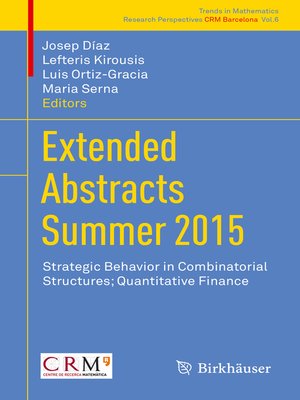Extended Abstracts Summer 2015
ebook ∣ Strategic Behavior in Combinatorial Structures; Quantitative Finance · Trends in Mathematics
By Josep Díaz

Sign up to save your library
With an OverDrive account, you can save your favorite libraries for at-a-glance information about availability. Find out more about OverDrive accounts.
Find this title in Libby, the library reading app by OverDrive.



Search for a digital library with this title
Title found at these libraries:
| Loading... |
This book is divided into two parts, the first of which seeks to connect the phase transitions of various disciplines, including game theory, and to explore the synergies between statistical physics and combinatorics. Phase Transitions has been an active multidisciplinary field of research, bringing together physicists, computer scientists and mathematicians. The main research theme explores how atomic agents that act locally and microscopically lead to discontinuous macroscopic changes. Adopting this perspective has proven to be especially useful in studying the evolution of random and usually complex or large combinatorial objects (like networks or logic formulas) with respect to discontinuous changes in global parameters like connectivity, satisfiability etc. There is, of course, an obvious strategic element in the formation of a transition: the atomic agents "selfishly" seek to optimize a local parameter. However, up to now this game-theoretic aspect of abrupt, locallytriggered changes had not been extensively studied.
In turn, the book's second part is devoted to mathematical and computational methods applied to the pricing of financial contracts and the measurement of financial risks. The tools and techniques used to tackle these problems cover a wide spectrum of fields, like stochastic calculus, numerical analysis, partial differential equations, statistics and econometrics. Quantitative Finance is a highly active field of research and is increasingly attracting the interest of academics and practitioners alike. The material presented addresses a wide variety of new challenges for this audience.






